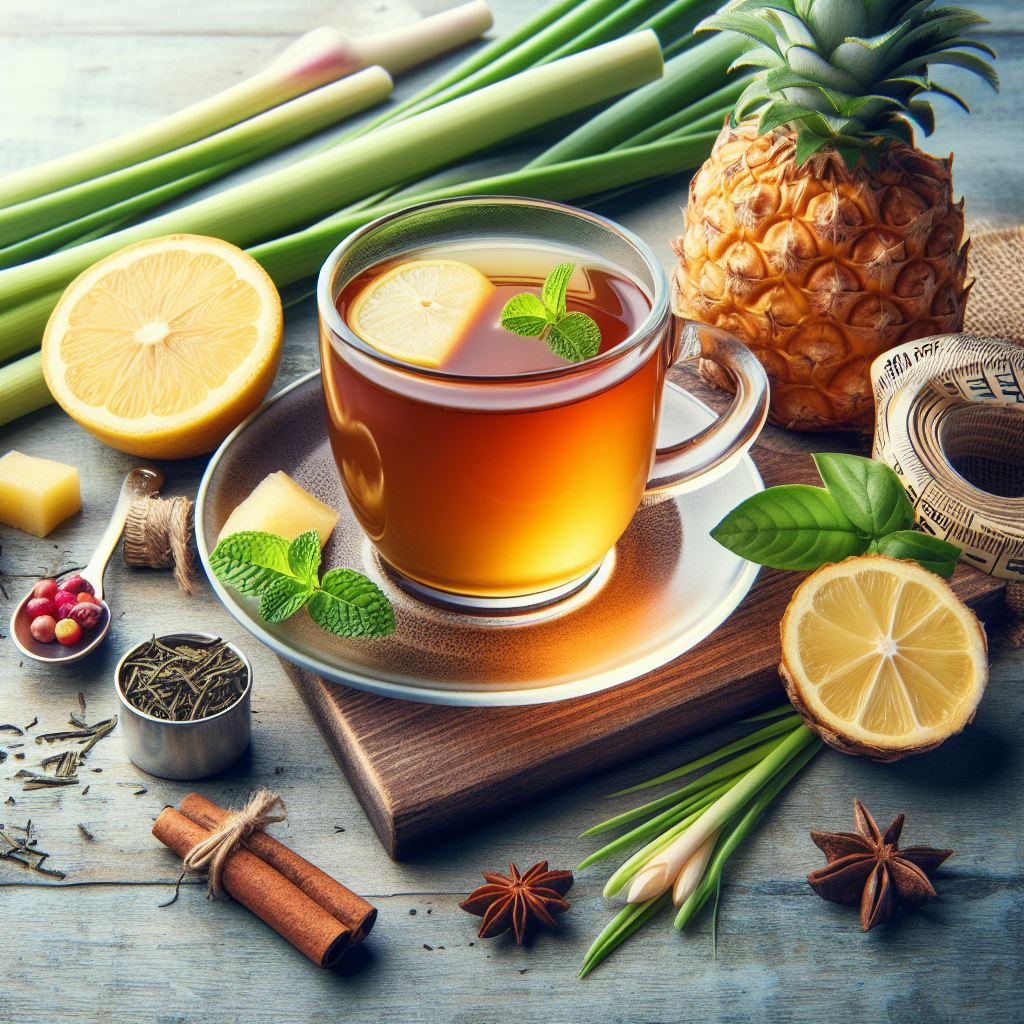Welcome to the herbal world of purple dead nettle tea, a brew that’s not only a feast for the eyes but a detox for the body. This vibrant herb, with its soft, purple-hued leaves, is more than just a pretty plant. Historically revered in herbal medicine and culinary traditions, purple dead nettle has been a go-to remedy for everything from allergies to sore throats.

What Is Purple Dead Nettle?
You may be wondering what exactly is a purple dead nettle, and how do you make it into a tea? Well, these plants are commonly confused with those pesky stinging nettles, since they look and sound similar. However, these weeds are from a entirely different breed! In fact, this type of plant doesn’t sting you, unlike the regular stinging nettles, and even has it’s own unique taste.
Purple dead nettle (Lamium purpureum) is a small perennial herbaceous plant that belongs to the mint family (Lamiaceae), which you can find them during Spring time and cold periods. Despite its unassuming appearance, this little wonder has much to offer. Let’s break it down:

Appearance:
- Leaves: As you can see, the leaves are heart-shaped or triangular with serrated edges. They grow symmetrically off the stalk and tend to droop as the plant matures, often folding over the leaf below them. The upper leaves may be dark purple or violet, while the lower portion of the stalk remains green.
- Flowers: Purple dead nettle produces small, bright pink flowers. These blooms are lipped, with an upper petal and two lower petals. They point downward and serve as an essential food source for bees in early spring.
- Stalk: The plant has a short, hollow stalk that is square in shape. While it can grow up to ten inches high, most plants reach a height of four to five inches. If the stalk is very tall, the leaves and flowers may only populate the upper portion.
Taste Profile:
Purple dead nettle has a mild, slightly grassy taste with floral undertones, perfect for tea! The purple tops even offer a touch of sweetness. However, despite being in the mint family, it lacks the typical minty flavor. Although, since they are from the same family, you could try mixing both mint leaves and purple dead nettle together for a unique and refreshing tea!
As for the texture, when brewed into tea, it provides a smooth, earthy texture that’s both comforting and refreshing.
Where to Find Purple Dead Nettle:
Embarking on a quest for purple dead nettle is relatively simple, since they are everywhere! Just be aware that they only grow fresh during Spring. In fact, this herb thrives in the embrace of early to mid spring. You’ll find it gracing disturbed habitats with its presence, usually basking in the full sun to light shade in areas with moist, fertile soil. Keep a look out in places such as:
- Thick lawns
- Gardens
- Roadsides
- Pastures
- Meadows
- Moist fallow fields
- In urban landscapes, look out for weedy edges of woodlands.
Keep your eyes peeled for its distinctive purple tinge and heart-shaped leaves, and you might just stumble upon this wild food right in your backyard! Check out this short video for a quick way to identify purple dead nettles, along with similar looking plants:
Health Benefits of Purple Dead Nettle Tea
What makes purple dead nettle tea so loved is its bountiful health benefits! Packed with antioxidants, it’s a champion at fighting off free radicals, those pesky molecules that love to wreak havoc in our bodies. It’s also believed to boost your immune system, making it ideal during cold and flu season.
Not only these, but there are many other health benefits you can gain from purple dead nettle tea. Here’s why this herbal tea deserves a spot in your tea cup:
1. Natural Antihistamine Properties
Bid farewell to the sniffles and sneezes of allergy season. Purple dead nettle acts as a natural antihistamine, easing symptoms like itchy eyes and runny noses without the drowsiness of over-the-counter meds.
2. Anti-inflammatory Effects
Inflammation is the root of many chronic woes, but purple dead nettle’s anti-inflammatory properties can help soothe conditions like arthritis, offering relief from pain and discomfort.
3. Digestive Health Support
Gentle on the tummy, this tea can alleviate digestive discomforts such as bloating and indigestion, promoting a happy, healthy gut.
4. Wound Healing
As an astringent and antimicrobial agent, purple dead nettle can be applied to wounds to stop bleeding and prevent infection, showcasing its versatility beyond the teacup.
5. Nutrient-Rich Brew
A sip of this tea is a gulp of goodness. Loaded with Vitamin C, iron, and fiber, it’s a simple way to boost your daily nutrient intake.
6. Detoxifying Properties
With mild diuretic properties, purple dead nettle tea can aid in flushing out toxins, supporting kidney health and contributing to overall well-being.
7. Calming Effects
Like a soft blanket for your mind, this tea can have a calming effect, helping to reduce stress and promote relaxation.
8. Antioxidant Powerhouse
The antioxidants in purple dead nettle tea can combat aging, reduce stress, and improve cognitive function, making it a smart choice for your mental acuity.
9. Heart Health
This deep purple herb isn’t just for show; it promotes heart health and fends off infections, making it a heartwarming addition to your wellness routine.
How to Make Purple Dead Nettle Tea
To begin with, you will need to find some purple dead nettle to put into your tea. As mentioned before, the best time to find this unique herb is in Spring. Once you have found the leaves, you will need to harvest and prepare them, ready for the tea brewing stage.
Harvesting and Preparing the Purple Dead Nettles

1. Gather the Plants
- Timing: Wait until the morning dew has dried. This is when the flavor of purple dead nettle is at its peak.
- Focus on Leaves: Most of the flavor resides in the fuzzy leaves. Snip each plant a few centimeters below the last leaf.
- Quantity: Aim for four to six plants for a full-bodied infusion.
2. Trim the Leaves
- Once you’ve gathered the plants, remove the leaves one by one.
- While you can use the flowers and stems, the tiny seeds tend to get stuck in your teeth. For a better experience, stick to the leaves.
3. Wash the Leaves
- Lastly, rinse the leaves in a bowl of water or give them a quick wash in the sink.
- This step removes any dirt, stray debris, or tenacious bugs. No need to dry them; they’ll get wet again during steeping.
For a more detailed guide on harvesting and preparing the leave, you can check out this dead purple nettle guide by Primal Survivor
How to Brew the Purple Dead Nettle Leaves Into Tea

Now you have the leaves prepared and ready, it’s time to start brewing them! Fortunately, the brewing process is super simple, much like brewing a regular tea. Even better, the leaves are easier to strain, since they are larger. Feel free to just pick them out with your hands, if you like. Here’s some further details on brewing purple dead nettle tea:
1. Ready Your Mug
- Firstly, Grab your favorite cup. You can either add the tea leaves directly to the bottom or use an infuser if you have one.
- When working with fresh herbs, go by flavor preference rather than precise measurements. Start with a small handful of leaves and adjust as needed.
2. Boil and Steep
- Fill your kettle with about eight ounces of water and set it to boil.
- Once it’s boiled, pour the hot water over the tea leaves in your cup.
- Steep for a few minutes. The longer you steep, the richer the flavor. For health benefits, consider steeping between five and ten minutes to maximize antioxidant levels.
3. Strain and Enjoy
- Lastly, remove the infuser (if used) or simply pick out the leaves with a spoon. Otherwise, discover How To Strain Tea Without a Strainer: 7 Easy Methods.
- Now you’re ready to sip a hot, yummy cup of purple dead nettle goodness! I like my tea with a bit of honey and lemon too.
For optimal quality, check out out guide on Loose Leaf Tea: How to Improve The Quality And Flavour in 4 Steps.
Additional Extras and Variations:

Feeling adventurous? Why not jazz up your cup with a sprinkle of mint for a refreshing twist or a dash of cinnamon for a spicy kick? The world of herbs is your oyster! Here’s some variations to get you inspired:
- Citrus Zing: Add a slice of lemon or orange to your tea for a citrusy kick. The tangy flavor complements the earthy notes of the nettle and adds a refreshing zest.
- Sweet Harmony: For those with a sweet tooth, a spoonful of honey or a sprinkle of brown sugar can transform your tea into a soothing, sweet brew. Find out The Best Sweeteners for Tea: How to Find Your Sweet Spot.
- Minty Fresh: Incorporate a few leaves of fresh mint or a dash of peppermint extract for a cool, invigorating twist that’s perfect for a hot summer day.
- Spiced: Embrace the warmth of spices by adding a cinnamon stick, a few cloves, or a pinch of ground ginger. These spices not only enhance the flavor but also offer their own health benefits. Learn how to make your own chai blends from scratch, and then just combine with dead purple nettles!
- Herbal Symphony: Combine purple dead nettle with other herbal teas like chamomile, lemongrass, or lavender for a symphony of flavors that also amplify the tea’s calming properties. Check out our article on the best teas for anxiety for more info.
- Iced Tea: Transform your tea into a cold treat by steeping it in cold or tepid water for two to three hours, then serving it over ice.
Conclusion
There you have it, a simple yet sublime way to enjoy purple dead nettle tea. Whether you’re a seasoned tea connoisseur or a curious newbie, this herbal infusion is sure to tickle your taste buds and nourish your soul. Additionally, it’s a fun way to get out and about and enjoy foraging during Spring. So go ahead, brew a cup, and let the magic of purple dead nettle weave its wellness into your day!





Leave a Comment